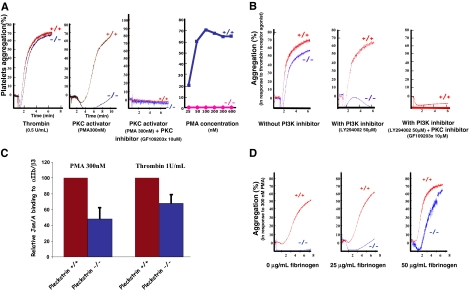Figure 3.
PKC-mediated aggregation is absent in pleckstrin-null platelets. (A) In contrast to their response to thrombin, washed pleckstrin-null platelets completely fail to aggregate in response to all doses of the PKC stimulant, PMA (25-600 nM). The third tracing from the left shows that the effect of PMA on platelet aggregation is completely ablated by the PKC inhibitor, GF109203x. The dose response was derived from 3 experiments. (B) The presence of a PI3K inhibitor completely eliminates the ability of pleckstrin-null platelets to aggregate in response to the peptide agonist of PAR4 (250 μM). Inhibition of wild-type platelets with both a PI3K inhibitor (LY294002) and PKC inhibitor (GF109203x) resulted in a total loss of aggregation in response to 250 μM of the PAR4 peptide agonist. The results are representative of 3 experiments. (C) Loss of pleckstrin also impairs the binding of Jon/A, an antibody that only recognizes the activated form of αIIbβ3. The mean and SD are derived from 6 experiments with PMA (P < .001) and 10 experiments with thrombin (P < .001). (D) The addition of exogenous fibrinogen reverts the aggregation defect of washed platelets lacking pleckstrin in response to 300 nM PMA. These results are representative of 3 experiments.

